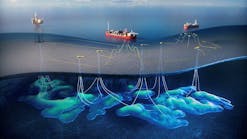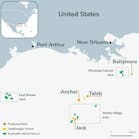RUSSIAN VENTURES - 3 HERE ARE CONSIDERATIONS IN EVALUATING RUSSIAN FLOW TESTS, RESERVOIR PERFORMANCE
Jack A. Krug
Questa Engineering Corp.
Golden, Colo.
William Connelly
Pangea International Inc.
Golden, Colo.
Flow test data contain some of the most important information for evaluation of a field. As part of the Russian evaluation process, research wells are extensively tested.
Three types of well tests are conducted: 1) drillstem tests, 2) production flow test (if the well flows to the surface), and 3) rising head test (if the well will not flow to the surface).
Drillstem tests are run in the open hole across potential pay zones. After casing is run, wells are flow tested with multiple-rate tests, and the bottom hole pressures are recorded during the build-up periods.
Results of the tests are summarized in test reports, on net pay maps, and on logs. The results from these tests include reservoir pressure, reservoir temperature, formation permeability, productivity index and damage ratio. This information provides the basis for estimating production capacities and future reservoir performance.
DRILLSTEM TEST
Russian drillstem tests are conducted in a similar manner to western methods and with very similar tools. Bottom hole and straddle tests are conducted. The open and closed times and sequences depend upon the zones being tested and the test objective.
Table 1 is a typical drillstem test summary as it might appear on a net pay map or annotated on a well log.
Russian analysis of the pressure build-up data uses the "Horner method" for calculating permeability and estimating the original reservoir pressure. The production rate during the flow period is estimated based on 1) the produced liquid volumes, or 2) the change in fluid level determined from the initial and final bottom hole flowing pressures. For the latter case, the production rate calculation uses the following equation:
[SEE FORMULA]
where PH and PK are, respectively, the final and initial flowing pressures, atm; S is drillpipe inside area, cm2 ; gamma is fluid specific gravity, gm/CM3; and T is flow time, minutes. The denominator constant of "1,000" should be "967.6."
The permeability and initial reservoir pressure are calculated from the slope and intercept of the Horner graph. The shut-in pressures are plotted versus the log [(T + ti)/ti], where ti is the shut in time. Base-10 logarithms are used.
The slope of the straight line passing through the last pressure points is "i" and the intercept is the estimated original reservoir pressure, Ppn . In western Siberia, original reservoir pressures tend to be normally or slightly overpressured.
The actual coefficient of productivity is calculated with the estimated flow rate and the drawdown pressure using the following equation:
[SEE FORMULA]
The flow capacity is referred to as the "hydrodynamic permeability" and is calculated with the following equation:
[SEE FORMULA]
Note that in this calculation the units of Q are cm3/sec.
The formation permeability, called the "strata-permeability," is calculated with the following equation:
[SEE FORMULA]
The undamaged (or potential) coefficient of productivity is calculated using the flow capacity term:
[SEE FORMULA]
The damage ratio is the ratio of the two productivities:
[SEE FORMULA]
Typically for drillstem tests, the damage ratio is greater than one, which indicates the formation is damaged.
The theoretical natural flow rate of a well is calculated using the following calculations:
[SEE FORMULA]
where HIIp, is the formation depth in meters and gamma is the flowing fluid specific gravity.
PRODUCTION TESTS
After casing is run and cemented, long term production tests are conducted beginning at the bottom of the wellbore. After a zone is tested in research wells, it is plugged off with cement and the next shallower zone is tested.
Testing of flowing oil wells can be a multirate test or an isochronal test sequence. Most flow tests we have reviewed are multirate tests with a prolonged final flow followed with a long term pressure build-up.
Production flow test data are summarized in a format similar to Table 2. This table reports the test interval, test times, choke size, production rates, and final pressures at the surface and bottomhole.
The test sequence shown in Table 2 consists of two flow periods followed by a 150 hr shut-in period followed by three additional flow periods. The reservoir pressure is measured and reported for each shut-in period and each build-up is analyzed and reported in the test report. The pressures are measured with a bottom hole pressure gauge similar to the Amerada RPG-3.
The wellbore configuration during many tests consists of tubing suspended from the wellhead. The flow rate is controlled at the surface and the tubing does not have a packer to isolate the annular volume from the tubing volume. Therefore the shut-in periods have extended wellbore storage times compared to a well tested with a downhole packer and downhole shutin valves.
The shut-in pressure data are plotted on three different graphs that provide the input to determine permeability, productivity, and flow efficiency calculations.
From a graph of log [t/(t+T)l vs. _P, the reservoir pressure Ppn is estimated from the final flowing pressure P3a6 and the estimated maximum build-up pressure at infinite shut-in time.
[SEE FORMULA]
The reservoir flow capacity is calculated using the slope of the straight-line portion of the last pressure data points and the following equation:
[SEE FORMULA]
The _Po is the ultimate drawdown pressure for the flow test and is used to calculate the productivity index for the zone:
[SEE FORMULA]
The slope and intercept (a and A respectively) and the slope (B) of t vs. In (d_P) dt provide the input data for the near wellbore flow capacity calculation:
[SEE FORMULA]
Rk = drainage radius, m; rc = wellbore radius, m; and Bo = formation volume factor.
With the permeability calculated near the wellbore and for the reservoir, the damage ratio is calculated with the following equation:
[SEE FORMULA]
We review the calculations and independently graph and calculate the reservoir characteristics using a modified Horner method. Many of the research wells are flow tested following acid stimulation treatments.
After treating, the damage ratio normally is about 1.0 or greater.
Some severely damaged wells do not respond to treatments. Fig. 1 illustrates our calculations for test data from a flow test similar to the one in Table 2.
It is important to review microlog separation over a tested interval to determine the net meters of permeability in the interval. The independent calculations usually have different final flow capacity values because of different net pay estimates and fluid property assumptions.
Non-flowing wells are tested using the "rising-head" method which is very similar to the method used to test water wells. It has the same limitations and analytical problems as a "slug test." Because the wells do not have packers, high pressure air can be pumped down the annulus to displace wellbore fluid from the tubing and the annulus.
The depth to which fluid may be displaced is limited by the available air pressure and/or by the tubing setting depth.
After the air pressure and liquid levels stabilize, the air pressure is released from the annulus, thus allowing the fluid level to U-tube and stabilize below the static level. In this condition the wellbore is at a pressure below reservoir pressure, so the well begins to flow into the wellbore until it once again stabilizes.
The increase in fluid level is measured versus time and is related to the build-up of pressure in the wellbore.
In the west, slug tests generally are analyzed using type curves. However, Russians use a graphical method of analysis. A typical graph of time versus natural log of the increasing fluid head is prepared. Using the slope (tga) and the area of the wellbore in square centimeters (F), the productivity of the zone is calculated:
[SEE FORMULA]
The productivity and permeability of the zones are estimated from these tests and are used to calculate the theoretical performance of the wells and the fields. Often the wells initially will flow, but generally after about two months they cease flowing and are placed on pump.
About 20% of the wells are produced with downhole submersible pumps and the rest are rod pumped.
The fourth article in this five part series discusses feasibility studies, including the development plan, costs, and economic analysis of the venture.
Copyright 1992 Oil & Gas Journal. All Rights Reserved.


